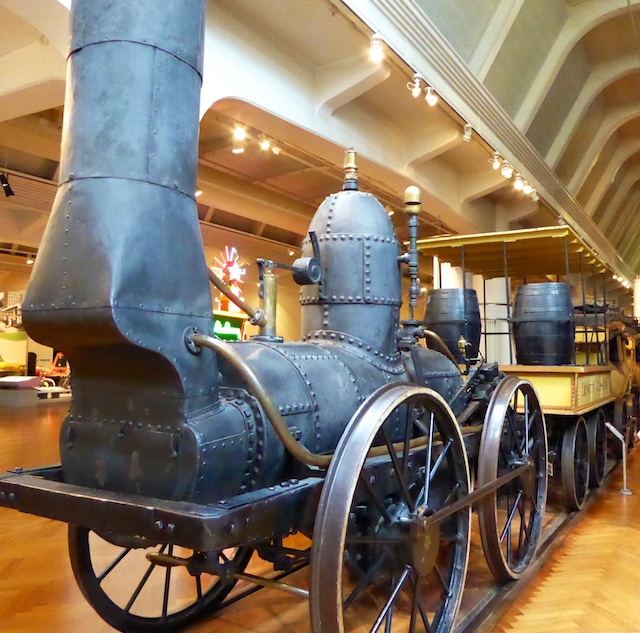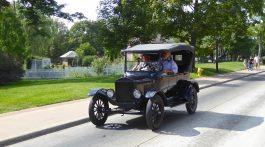The Henry Ford Museum in Dearborn, Michigan is part of what has become know as ‘The Henry Ford‘, a vast campus which includes the Henry Ford Museum, Greenfield Village and the Ford factory, home to over 26 million artifacts. It was constructed from Henry Ford’s desire to preserve items of historical significance and portray the Industrial Revolution. Housing a vast array of famous homes, machinery and exhibits, including John F. Kennedy’s presidential limousine, Thomas Edison’s laboratory and the Wright Brothers’ bicycle shop, the Henry Ford is the largest outdoor museum complex in America. It tells the story of American ideas and innovation, it is inspiring and utterly captivating!
The Henry Ford Museum was dedicated to Thomas Edison, Henry Ford’s life long friend, on October 21, 1929, the 50th anniversary of the first successful incandescent light bulb; the museum opened in 1933. Henry Ford said of his museum “I am collecting the history of our people as written into things their hands made and used…. When we are through, we shall have reproduced American life as lived, and that, I think, is the best way of preserving at least a part of our history and tradition..”
Henry Ford (1863-1947) grew up on a farm in Wayne County near Dearborn, Michigan and from an early age was drawn to industry and engineering. At age 16 he left home to become an apprentice at a machinist in Detroit. By 1893 he was the chief engineer for the Edison Illuminating Company.
Henry Ford’s Kitchen Sink Engine
On December 24th 1893 Henry clamped his first experimental engine, made from bits of scrap metal, onto the family kitchen sink. His wife Clara poured gasoline into the intake valve while Henry wired the spark plug to an over head light and spun the fly wheel. The little engine coughed and roared into life.

By 1896 Ford had constructed his first model, the Ford Quadricycle. When he presented his plans to Thomas Edison, Edison encouraged him to build a second, better model, which of course he did!
Henry Ford was working during an exciting time of great change. The concept of the department store had just been born and in 1898 New York’s B. Altman and Company began using electric driven delivery vans to deliver goods to their customers.

In 1903, Henry Ford established the Ford Motor Company. That same year Packard’s Model F was driven by Tom Fetch from San Francisco to New York. Fetch’s companion, Marius Krarup, was the editor of ‘The Automobile’, and he filed stories for the magazine which afterwards he commented was a journey he had no desire to do again!

When one looks at the condition of the ‘roads’ of the time, little more than muddy tracks, it is surprising that they even made the several thousand mile journey and that they did it in just 61 days!

The DeWitt Clinton Steam train
The other revolutionary mode of transport, the steam train, had made its debut over half a century earlier. This 1831 ‘DeWitt Clinton’ was the third train in America. The locomotive pulled five carriages and the tender which carried water barrels and pinewood for fuel. The first three cars were stagecoaches, looking very similar to their horse drawn counterparts and the last two were open with planks running their entire length where the passengers sat sideways. This reproduction model, constructed for the exhibition in the 1893 Chicago World Fair, was given to the Henry Ford Museum in 1935.

The Allegheny
By 1941 steam trains had developed greatly. The Allegheny was the largest and most powerful ever built. It was about 1.25 miles long and could travel up to 60mph. It was used to transport freight, mostly coal and then troops during World War II. However it was no match for the much faster and more efficient diesel locomotive which eventually replaced it.

1908 Ford Model T & S
As the development of the train progressed Ford pursued his ideas for the automobile. His revolutionary vision was for the manufacture of an inexpensive automobile made by skilled workers earning steady wages. The Model T made its debut in 1908 with a purchase price of $825.00. Over ten thousand were sold in its first year, establishing a new record. Four years later the price dropped to $575.00 and sales soared.

1914 Ford Model T
In 1914, Ford sponsored the development of the moving assembly line technique of mass production. Simultaneously, he introduced the $5-per-day wage ($110 in 2011) as a method of keeping the best workers loyal to his company. By 1914, Ford could claim a 48% share of the automobile market. Simple to drive and cheap to repair, by 1918 half of all cars in America were Ford Model T’s.
Ford is famous for saying “they can have any color they want as long as its black”. One colour because it made production faster and black because it was the least expensive and most durable.

1930 Ford Touring car
By the 1930’s a new vision and a new era had developed
1965 Lotus Ford
A few decades later the story of the motorcar had changed dramatically. This 1965 revolutionary Ford collaboration with the British manufacturer Lotus, for the first time positioned the engine in the rear and astounded the American motor racing world by winning the Indianapolis 500. A traditional front engine car never won again.

1967 Ford Mark IV Le Mans Champion
Two years later, the Ford Mark IV was the first all American car and all American team to win the previously European dominated 24 hour Le Mans race in France.

The Wright Brothers and flight
As the automobile was to revolutionize every day travel for ordinary people, the development of the aeroplane would eventually change travel between the continents and across the globe in a way which previously had seemed totally fanciful. In 1903, even before Ford had introduced his Model T, two bicycle mechanics, Orville and Wilbur Wright, from Dayton, Ohio, propelled themselves and the rest of the world into a new age. On December 17, 1903, Orville Wright piloted the first powered airplane 20 feet above a wind-swept beach in North Carolina. The flight lasted 12 seconds and covered 120 feet.

1926 Flivver light aircraft
In 1926 Henry Ford created one of the world’s first small affordable planes the Flivver, the Model T for the air!. Sadly it proved to be both expensive and dangerous and the concept of the small private plane faded, history would prove otherwise.

The Ford Lincoln’s Presidential vehicles.
1902 President Teddy Roosevelt’s Brougham
Teddy Roosevelt was not a fan of the automobile, its development was in its infancy during his presidency and he preferred to travel by horse drawn carriage.

1939 President Franklin D. Roosevelt’s Lincoln Special
This was the first car designed and built for a president. It was custom made with special features to be able to lift the paralyzed president from his wheel chair into the car.

1950’s President Eisenhower’s Lincoln ‘Bubbletop’
President Truman first rode this flashy convertible in 1950. President Eisenhower later had the car fitted with a removable plexiglass top which allowed him to see and be seen even in bad weather. The car soon became known as the ‘bubbletop’.

1961, President Kennedy’s Lincoln
A modern, four door convertible, tragically also the vehicle in which President Kennedy was shot in Dallas in 1963. The Secret Service had it modified for Johnson’s and Nixon’s presidencies.

1972, President Reagan’s Lincoln
Like all presidential cars following Kennedy’s assassination this was a completely armored closed car with a permanent roof and bullet proof glass. But conceding with a president’s desire to be seen, a sunroof panel could be opened for two people to stand up.

This is just a tiny snapshot of the incredible Henry Ford Museum. There are many other fascinating exhibits telling the story of the American industrial revolution, including the development of electricity and its dramatic impact on the lives of ordinary people. Do visit to this fabulous museum you won’t be disappointed!





No Comment